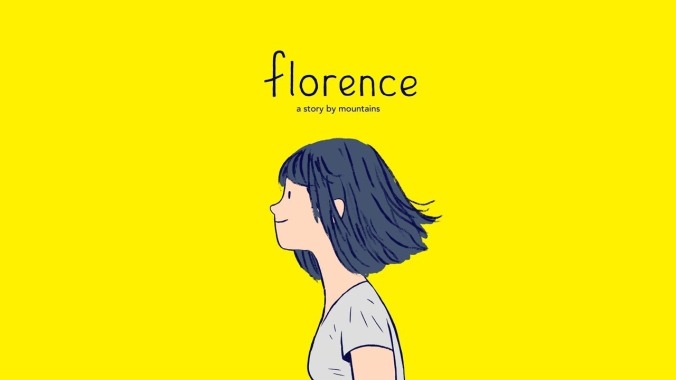Florence tells a familiar story in a wordless new form
Games Features What Are You Playing This Weekend?
Every Friday, A.V. Club staffers kick off our weekly open thread for the discussion of gaming plans and recent gaming glories, but of course, the real action is down in the comments, where we invite you to answer our eternal question: What Are You Playing This Weekend?
Florence
There are barely any words in Florence, but you can tell a lot about the game by the way it describes itself. It’s billed not as a game but “an interactive story”; hit the “about” page and you’ll see that designer Mountains calls itself “a craft games studio.” The story traces the rise and fall of a relationship between Florence Yeoh, a 24-year-old aspirant artist, and a cellist she bumps into on the street. The plot beats are familiar—they go to museums together, fight at a grocery store, have a bittersweet move-in montage—but the execution is not, skillfully blurring the line between a comic book and a game, with graceful artwork and swirling minimalist music. Told across 20 chapters, most of which take only a minute or so to complete, it has the feel of a debut film, making a few bold stylistic choices within the context of a tried-and-true narrative format.
And just like such a debut film, it leaves you with no real impression of its own, but plenty of optimism about the creator’s promise. I’m endlessly fond of the idea of a video game as a friction-free short story; last year’s A Mortician’s Tale, for example, was a sober and thoughtful look at death, with a graceful story appended over top. You were in and out in 30 minutes, but I still remember the feeling of removing jewelry from a corpse before tossing it in the cremator or being the sole attendee of a homeless man’s funeral. Florence has interesting and skillfully executed ideas in it—most notably, a nonverbal approach to dialogue that suggests the inexact nature of language—but it mostly floats by, heartfelt, thoughtful, and intentionally light. There is a mark of bravery in making such a game at all. If you have a decent-length commute or road trip in your future, you won’t regret the little bit of time it takes to experience it. [Clayton Purdom]
Way Of The Passive Fist
We ran down the basics of Household Games’ Way Of The Passive Fist back in our March games preview, but here’s the elevator pitch: What if you took a classically styled beat-’em-up like Final Fight and completely removed your ability to attack the hundreds of martial arts mooks that came at you? Instead of flailing away, you have to be a zen master, holding your ground and perfectly defending against attacks until your enemies tire out and can be nudged into non-existence. They punch, you parry. They go to grapple, you dodge. If you chain together enough perfectly executed defenses, you build up a meter that grants a single powerful punch to knock an enemy out right away (or at least deplete a big chunk of their stamina). And so it goes until you’ve wiped all these thugs away.
Even just reading that description, it’s obvious the dulling force of repetition will be the biggest issue Passive Fist runs up against. Household mixes things up by introducing new enemies and variants of ones you’ve already fought, quickly ratcheting up the amount of patterns and variables you have to consider to get through the game’s gauntlets. Like going up against an unfamiliar foe in the fighting games that inspired it, it’s easy to get caught off guard by something new Passive Fist sends your way. But getting worked up and exerting pressure on your enemies or throwing around ill-considered power punches is a great way to get your ass kicked. The answer is to keep cool, observe, adapt, and grow, a universal and deeply satisfying process of all video games that Passive Fist adeptly lays bare.
It’s not perfect, though. The environmental hazards the game mixes in to further shake up its routine are always well telegraphed and can be exploited to hit your enemies, too, but they come with wonky hit detection that can lead to some awfully unfair, flow-destroying moments. You can only block attacks coming from your front, which makes sense and adds to the importance of positioning but causes a lot of unforeseen issues when the screen starts to fill up with bad guys and you find yourself overlapping with one, unable to predict what side their next punch will come from. On an aesthetic level, perhaps the most important level for beat-’em-ups, the sprite work is big and colorful but nowhere near as characterful or stylish as the games Passive Fist aims to emulate. The soundtrack fares better, though, powerfully evoking the 16-bit butt rock of the game’s early ’90s inspirations. [Matt Gerardi]